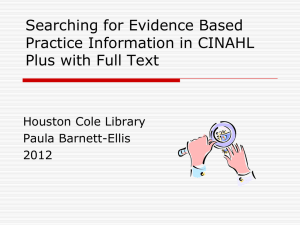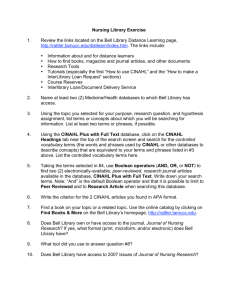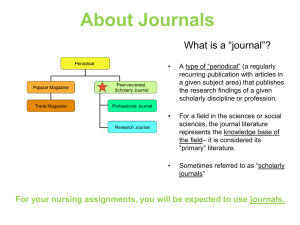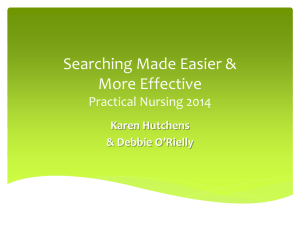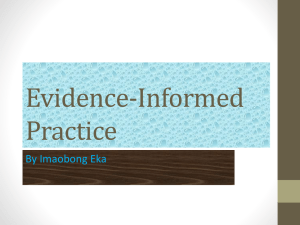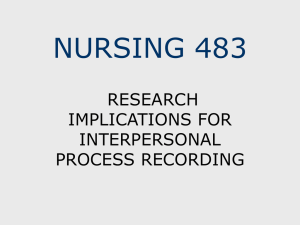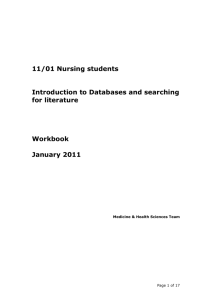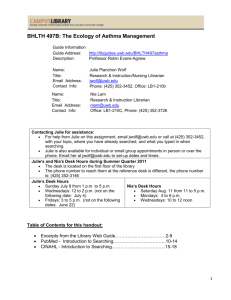Searching CINAHL for Journal Articles Updated Aug. 2008 Dr
advertisement
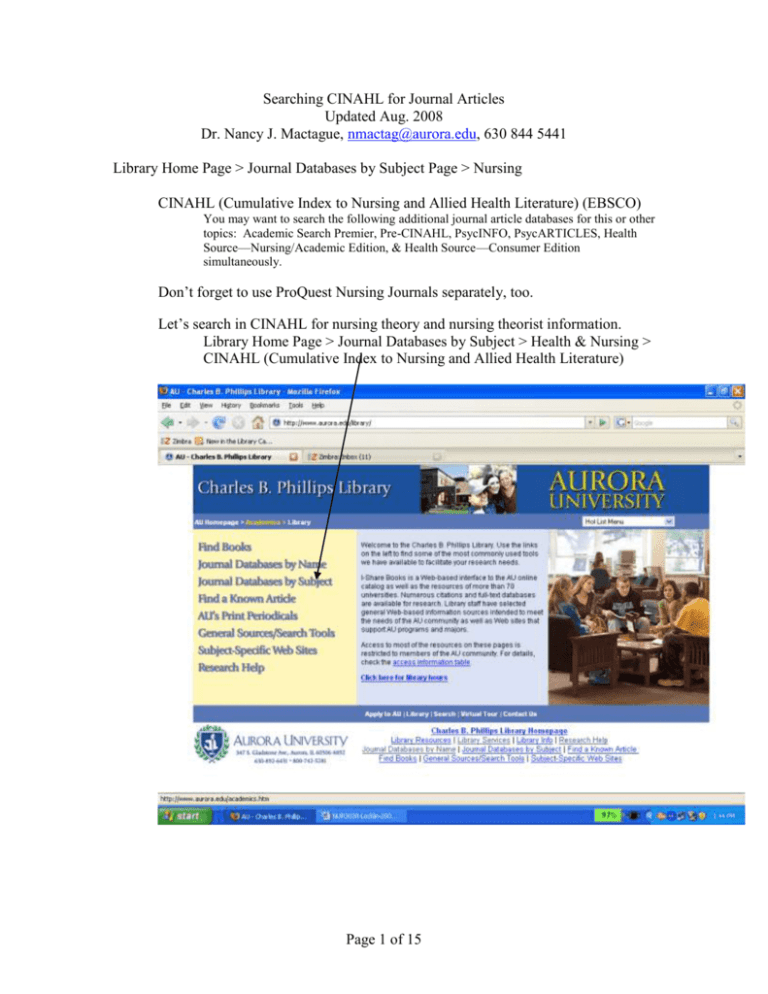
Searching CINAHL for Journal Articles Updated Aug. 2008 Dr. Nancy J. Mactague, nmactag@aurora.edu, 630 844 5441 Library Home Page > Journal Databases by Subject Page > Nursing CINAHL (Cumulative Index to Nursing and Allied Health Literature) (EBSCO) You may want to search the following additional journal article databases for this or other topics: Academic Search Premier, Pre-CINAHL, PsycINFO, PsycARTICLES, Health Source—Nursing/Academic Edition, & Health Source—Consumer Edition simultaneously. Don’t forget to use ProQuest Nursing Journals separately, too. Let’s search in CINAHL for nursing theory and nursing theorist information. Library Home Page > Journal Databases by Subject > Health & Nursing > CINAHL (Cumulative Index to Nursing and Allied Health Literature) Page 1 of 15 Health & Nursing Page 2 of 15 CINAHL Plus with Full-Text. Note the other databases for nursing! Page 3 of 15 Clicking “Full text Journals (and other sources) – General” will get you into all of the databases offered through EBSCO. The databases (for books, journals, etc.) contain the information. EBSCO is a provider of the databases. We pay EBSCO for access to the databases. When you cite your sources, you will include the database name, such as CINAHL Plus with Full Text. Page 4 of 15 This is the top of the page that allows you to choose databases. You could search all of these at once, but for this demonstration we’ll choose CINAHL Plus with Full Text. So, we need to scroll down. Page 5 of 15 Put a check in the box next to CINAHL Plus with Full Text. Note that Pre-CINAHL is also offered. It is a Pre-Publication database, that is, the citations come out even before the print journal is published. Therefore, full-text of these articles is not yet available. Put a check in the box next to CINAHL Plus with Full Text. Farther down you will see two Health Source databases, and even farther down – off the bottom is Pre-CINAHL. (These are in alphabetical order.) Page 6 of 15 Type “nursing theor*” in the search box and put a check in the box next to Full Text. What do the symbols do? What does the asterisk do? Truncation cuts off the end of the word and searches for different endings, such as –ed, -ing, -s, -es, etc. Wildcard looks for a letter within a word, such as wom?n, or m?n. Page 7 of 15 You have 764 items. Wow! Too many! Click Advanced Search. Page 8 of 15 In an empty search box enter the name of your theorist. I’ll use Orem. Re-check the fulltext box. Note limiters for each database, including peer-reviewed/scholarly journals. Page 9 of 15 So for Dorothea Orem I have 32 items. Page 10 of 15 To see additional information about an article, mouse over the magnifying glass. For some articles the pop-up box will give you an abstract, which is a summary of the article’s contents. If you want to see the full article, click the PDF Full Text link. Page 11 of 15 You can print or email this article. Use the Result List link to go back to the long list of items. Page 12 of 15 If I need more information, I can uncheck the Full-Text limiter, and I will have 179 articles. You will see the Find It link. Page 13 of 15 What if the article you want isn’t full-text online? 1. Click here to check availability. You will either get a link to the full-text in a different database, or you will get an Inter-Library Loan request form, which is shown below. Click GO Page 14 of 15 Enter your personal information. Make sure your email is correct! 2. Library Home Page > Find A Known Article (index, by journal title, to full-text, on-line journals to which we subscribe) 3. Library Home Page > AU’s Print Periodicals 4. To request items from other schools: Books and Articles: Library Home Page > Library Services > Document Delivery Request Form (for books and journal articles) Requesting Materials through Inter-Library Loan (electronically) ALLOW ONE TO TWO WEEKS ALSO: The amount of time you can keep books, and the number of times you can renew books is determined by the lending library. Page 15 of 15
